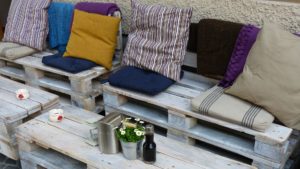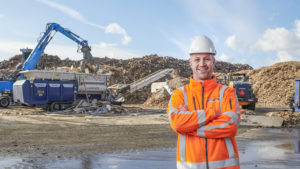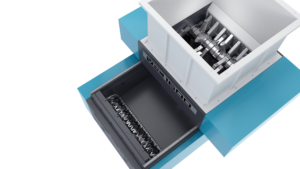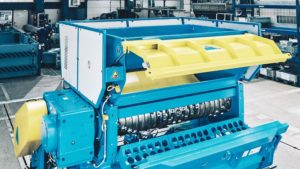Wood Waste
Brits turning to pallet furniture…

These flat wooden structures are commonly used for the transportation and display of goods in the likes of supermarkets and storage facilities but… have you ever thought of a pallet table or sofa?
Although this idea may sound rather bizarre, pallet furniture is becoming ever more popular in the UK, and it’s a great way to recycle used timber. Recent Google search data found that ‘pallet furniture’ is becoming an increasingly searched term across the UK, increasing from just 4,400 searches in January 2019, to 74,000 by May 2020.
So, just how can pallets be used in our homes and offices? UK social housing provider, Believe Housing, offer some insight:
Pallet tables
Whether it be for the central dining room piece or a stand to display your favourite family photos on, the term ‘pallet tables’ has experienced significant increases in monthly search volumes from January 2019, accounting for 880 searches, to 6,600 searches in May 2020. It seems the nation is looking for creative new coffee tables too, with the term ‘pallet coffee tables’ increasing from 1,600 searches in January 2019, to 4,400 searches in May 2020.
How to make:
Firstly, decide what size coffee table you want and purchase three pallets that match the size. Alternatively, saw the pallet you have to be the size and shape.
Since pallets tend to have large spaces between each wooden slat, remove the slats from one of the other pallets using a hammer and chisel and nail them in between the gaps of your main pallet. Make sure to remove all the old nails out of the pallet and secure the slats with new ones. Already, your coffee tabletop has appeared!
For the legs of the table, use the third pallet you have and saw the slats to meet the length required of the tabletop. For extra strength and balance, use the full thickness of the third pallet, rather than just the individual slats. Then nail them to the tabletop using carriage bolts for extra strength. Finally, smooth the surface down using sanding paper and paint with wood stain.
Once the woodwork is done, decorate the table however you please…
Pallet bed
Although a wooden pallet doesn’t sound like the comfiest surface to sleep on every night, it can make for a stylish and rustic frame for a low-platformed mattress to be placed on. So much so that the term ‘pallet bed frames’ has dramatically increased on Google over the last year, going from being searched 720 times in January 2019, to 1,600 times in August 2020. As for the term ‘pallet bed’, this is found to be increasingly talked about. This term rose from 5,400 searches in January 2019 to 12,100 searches in August 2020.
Garden furniture
 The term ‘pallet garden furniture’ has found to be an increasingly searched for choice of décor, with the term increasing from 1,300 searches in January 2019, to 14,800 searches in June 2020. For those that are looking for a new addition to your deck area, the term ‘pallet sofa’ has excelled in popularity over the years. The phrase was searched for 880 times in January 2019, rising to 12,100 searches in July 2020.
The term ‘pallet garden furniture’ has found to be an increasingly searched for choice of décor, with the term increasing from 1,300 searches in January 2019, to 14,800 searches in June 2020. For those that are looking for a new addition to your deck area, the term ‘pallet sofa’ has excelled in popularity over the years. The phrase was searched for 880 times in January 2019, rising to 12,100 searches in July 2020.
With the recycling of pallets as furniture pieces on the rise it seems that, when it comes to quirky home décor, there is inspiration wherever you look!
Brits turning to pallet furniture…

These flat wooden structures are commonly used for the transportation and display of goods in the likes of supermarkets and storage facilities but… have you ever thought of a pallet table or sofa?
Although this idea may sound rather bizarre, pallet furniture is becoming ever more popular in the UK, and it’s a great way to recycle used timber. Recent Google search data found that ‘pallet furniture’ is becoming an increasingly searched term across the UK, increasing from just 4,400 searches in January 2019, to 74,000 by May 2020.
So, just how can pallets be used in our homes and offices? UK social housing provider, Believe Housing, offer some insight:
Pallet tables
Whether it be for the central dining room piece or a stand to display your favourite family photos on, the term ‘pallet tables’ has experienced significant increases in monthly search volumes from January 2019, accounting for 880 searches, to 6,600 searches in May 2020. It seems the nation is looking for creative new coffee tables too, with the term ‘pallet coffee tables’ increasing from 1,600 searches in January 2019, to 4,400 searches in May 2020.
How to make:
Firstly, decide what size coffee table you want and purchase three pallets that match the size. Alternatively, saw the pallet you have to be the size and shape.
Since pallets tend to have large spaces between each wooden slat, remove the slats from one of the other pallets using a hammer and chisel and nail them in between the gaps of your main pallet. Make sure to remove all the old nails out of the pallet and secure the slats with new ones. Already, your coffee tabletop has appeared!
For the legs of the table, use the third pallet you have and saw the slats to meet the length required of the tabletop. For extra strength and balance, use the full thickness of the third pallet, rather than just the individual slats. Then nail them to the tabletop using carriage bolts for extra strength. Finally, smooth the surface down using sanding paper and paint with wood stain.
Once the woodwork is done, decorate the table however you please…
Pallet bed
Although a wooden pallet doesn’t sound like the comfiest surface to sleep on every night, it can make for a stylish and rustic frame for a low-platformed mattress to be placed on. So much so that the term ‘pallet bed frames’ has dramatically increased on Google over the last year, going from being searched 720 times in January 2019, to 1,600 times in August 2020. As for the term ‘pallet bed’, this is found to be increasingly talked about. This term rose from 5,400 searches in January 2019 to 12,100 searches in August 2020.
Garden furniture
 The term ‘pallet garden furniture’ has found to be an increasingly searched for choice of décor, with the term increasing from 1,300 searches in January 2019, to 14,800 searches in June 2020. For those that are looking for a new addition to your deck area, the term ‘pallet sofa’ has excelled in popularity over the years. The phrase was searched for 880 times in January 2019, rising to 12,100 searches in July 2020.
The term ‘pallet garden furniture’ has found to be an increasingly searched for choice of décor, with the term increasing from 1,300 searches in January 2019, to 14,800 searches in June 2020. For those that are looking for a new addition to your deck area, the term ‘pallet sofa’ has excelled in popularity over the years. The phrase was searched for 880 times in January 2019, rising to 12,100 searches in July 2020.
With the recycling of pallets as furniture pieces on the rise it seems that, when it comes to quirky home décor, there is inspiration wherever you look!
Rough tools for fine particles

That’s where the Tuytel Group is based and where it has been renting out heavy construction machinery as well as offering transport solutions and recycling machines in the Netherlands and all across Europe since 1999. In the matter of machines for processing waste wood, the company relies on Lindner‘s robust solutions, supplied and supported by Dutch sales partner Van der Spek Vianen B.V.
At the beginning of 2020, a system solution consisting of the Urraco 95DK shredder and a Zeta Star 95DK star screen was added to a fleet that has been home to two mobile twin-shaft shredders of the Urraco 75 series for quite some time. ‘As a heavy equipment rental company we focus specifically on premium machines from top European brands. We have to offer our clients solutions with maximum reliability and the lowest possible maintenance costs,’ explains Jan Arie van der Meijden, responsible for Tuytel Group’s recycling division. And adds: ‘When purchasing a new waste wood processing solution, we looked at different technical equipment on the market. In the end we came back to Lindner. Our experiences with our two Urracos have been fantastic, but the sturdy welded cutting system and the exact output size were the deciding factors. With a throughput of approximately 65 metric tons/hour, the shredding unit endures high loads. We do not want our customers to have to retighten or even replace the knives every 80 hours. The Urraco 95DK shredder easily operates 600 to 700 hours without intervention and does so with a clean output and no great anomalies.’
Tuytel processes waste wood of the Dutch grades A, B and C, but mainly category B waste wood, i.e. waste wood that is not contaminated by wood preservatives or organohalogen substances. The company offers its customers the Urraco 95DK as a single-step processing solution for particle sizes of 90% <180 mm. The machine is equipped with Lindner’s patented LW cutting system, which was specifically developed for waste wood processing. Furthermore, by using Lindner’s Zeta Star 95DK star screen, finer fractions can be produced up to a particle size of P100 according to ISO standard 17225-1. Tuytel also provides the option of renting the machines with an operator. The majority of the processed waste wood is shipped and ultimately used for energy recovery. ‘In addition to the precisely defined output, it is extremely important to our clients that the rented solution can also be operated at high productivity. That’s where our Lindner machines give us a crucial advantage with their ease of operation and very long maintenance intervals. This means the operator can focus on feeding the machine and the shredder takes care of the rest,’ summarises van der Meijden.
Rough tools for fine particles

That’s where the Tuytel Group is based and where it has been renting out heavy construction machinery as well as offering transport solutions and recycling machines in the Netherlands and all across Europe since 1999. In the matter of machines for processing waste wood, the company relies on Lindner‘s robust solutions, supplied and supported by Dutch sales partner Van der Spek Vianen B.V.
At the beginning of 2020, a system solution consisting of the Urraco 95DK shredder and a Zeta Star 95DK star screen was added to a fleet that has been home to two mobile twin-shaft shredders of the Urraco 75 series for quite some time. ‘As a heavy equipment rental company we focus specifically on premium machines from top European brands. We have to offer our clients solutions with maximum reliability and the lowest possible maintenance costs,’ explains Jan Arie van der Meijden, responsible for Tuytel Group’s recycling division. And adds: ‘When purchasing a new waste wood processing solution, we looked at different technical equipment on the market. In the end we came back to Lindner. Our experiences with our two Urracos have been fantastic, but the sturdy welded cutting system and the exact output size were the deciding factors. With a throughput of approximately 65 metric tons/hour, the shredding unit endures high loads. We do not want our customers to have to retighten or even replace the knives every 80 hours. The Urraco 95DK shredder easily operates 600 to 700 hours without intervention and does so with a clean output and no great anomalies.’
Tuytel processes waste wood of the Dutch grades A, B and C, but mainly category B waste wood, i.e. waste wood that is not contaminated by wood preservatives or organohalogen substances. The company offers its customers the Urraco 95DK as a single-step processing solution for particle sizes of 90% <180 mm. The machine is equipped with Lindner’s patented LW cutting system, which was specifically developed for waste wood processing. Furthermore, by using Lindner’s Zeta Star 95DK star screen, finer fractions can be produced up to a particle size of P100 according to ISO standard 17225-1. Tuytel also provides the option of renting the machines with an operator. The majority of the processed waste wood is shipped and ultimately used for energy recovery. ‘In addition to the precisely defined output, it is extremely important to our clients that the rented solution can also be operated at high productivity. That’s where our Lindner machines give us a crucial advantage with their ease of operation and very long maintenance intervals. This means the operator can focus on feeding the machine and the shredder takes care of the rest,’ summarises van der Meijden.
Vecoplan: Pre-shredder for voluminous objects and bulky wooden items

When combined with the VHZ single-shaft shredder, it can increase throughput by up to 50%.
With its large and powerful single-shaft shredders, Vecoplan offers efficient solutions for reliably processing voluminous wooden items such as pallets in continuous operation. However, until now, a larger VAZ series machine had to be used for large and bulky items – and this also required a correspondingly larger installation area than the new combined solution with the VHZ 1600 and VPC 1600. “In addition to the large amount of space required, there’s also another point to consider – the throughput is relatively low if we feed these pallets directly to a shredder,” says Ralf Rosenkranz, Area Sales Manager for Vecoplan’s Wood | Biomass division. The reason for this is that “a lot of air is between the material“ due to the design of the pallets with their spaced boards and skids, so the shredding process takes a relatively long time.
There has been a considerable increase in the demands placed upon material and distribution centres in particular and on American DIY stores that often use disposable pallets – and this is why the machine manufacturing company from the Westerwald decided to develop an efficient pre-shredder, the Vecoplan VPC 1600 pallet crusher. “We set ourselves the goal of increasing throughput capacity by up to 50% for the shredding of bulky pallets and even large boxes – and we have achieved that goal,” says Rosenkranz. These items are crushed, not cut in the VPC. This creates enormous advantages in the shredding process, and the customer benefits from reduced quantities of wearing parts
With its working width of 1,600 millimetres, the 800 millimetre-high VPC fits exactly onto the VHZ. A sliding frame connects the shredder and the pre-shredder. The VPC is permanently fixed during operation. For example, if the machine or plant operator has to change the counter-knives in the shredder, he can easily move the 5.5-tonne VPC. “A crane would have been too time-consuming and costly,” says Rosenkranz.
The filler port of the new pre-shredder measures 1,605 x 1,605 millimetres and the drive power is 2 x 9.2 kilowatts. Sixteen counter-crushers have been integrated into the machine and it also has two independently running rotors, each with a speed of ten revolutions per minute. “If an over-torque occurs briefly during operation, the two rotors can reverse
Vecoplan: Pre-shredder for voluminous objects and bulky wooden items

When combined with the VHZ single-shaft shredder, it can increase throughput by up to 50%.
With its large and powerful single-shaft shredders, Vecoplan offers efficient solutions for reliably processing voluminous wooden items such as pallets in continuous operation. However, until now, a larger VAZ series machine had to be used for large and bulky items – and this also required a correspondingly larger installation area than the new combined solution with the VHZ 1600 and VPC 1600. “In addition to the large amount of space required, there’s also another point to consider – the throughput is relatively low if we feed these pallets directly to a shredder,” says Ralf Rosenkranz, Area Sales Manager for Vecoplan’s Wood | Biomass division. The reason for this is that “a lot of air is between the material“ due to the design of the pallets with their spaced boards and skids, so the shredding process takes a relatively long time.
There has been a considerable increase in the demands placed upon material and distribution centres in particular and on American DIY stores that often use disposable pallets – and this is why the machine manufacturing company from the Westerwald decided to develop an efficient pre-shredder, the Vecoplan VPC 1600 pallet crusher. “We set ourselves the goal of increasing throughput capacity by up to 50% for the shredding of bulky pallets and even large boxes – and we have achieved that goal,” says Rosenkranz. These items are crushed, not cut in the VPC. This creates enormous advantages in the shredding process, and the customer benefits from reduced quantities of wearing parts
With its working width of 1,600 millimetres, the 800 millimetre-high VPC fits exactly onto the VHZ. A sliding frame connects the shredder and the pre-shredder. The VPC is permanently fixed during operation. For example, if the machine or plant operator has to change the counter-knives in the shredder, he can easily move the 5.5-tonne VPC. “A crane would have been too time-consuming and costly,” says Rosenkranz.
The filler port of the new pre-shredder measures 1,605 x 1,605 millimetres and the drive power is 2 x 9.2 kilowatts. Sixteen counter-crushers have been integrated into the machine and it also has two independently running rotors, each with a speed of ten revolutions per minute. “If an over-torque occurs briefly during operation, the two rotors can reverse
Promising results from asphalt research project

Extensive testing shows that a new asphalt formulation using recycled polyethylene (rPE) film recovered from retail locations could achieve many of the same benefits of traditional polymer-modified asphalt formulations, including improved performance, decreased cost, and increased lifespan of asphalt. The new formulation represents a sizable end-market opportunity for recycled mixed films.
PLASTICS partnered with NCAT to conduct a battery of tests using federal and state transportation standards, a necessary step before large-scale implementation across the U.S.
“PLASTICS is proud to have worked with NCAT, and all of our project partners, to produce the most comprehensive set of data on the effects of rPE in asphalt. We’re making our research publicly available in an open-source format,” said PLASTICS’ President and CEO, Tony Radoszewski. “The entire plastics industry is working to demonstrate the application of recycled material.”
Research shows that even in small amounts, rPE could improve properties such as stiffness and
resistance, without cracking due to low temperature or fatigue. With the right blend of rPE and a reactive co-polymer additive, new asphalt formulations match the effectiveness of traditional styrene-butadiene-styrene block copolymer (SBS) at less cost.
“As a leading institute for asphalt research, NCAT was well equipped to work with our plastics industry partners to develop new formulations that can use recycled plastics,” said NCAT’s Assistant Research Professor, Fan Yin. “This not only creates a new and important end market opportunity but lays important groundwork for further testing around improving the lifespan and performance of roadways using recycled feedstocks – creating an environmental win-win for the asphalt industry.”
Based on successful lab-scale research on the latest rPE formula, PLASTICS is now working with several companies to use it on privately-funded roadways and parking lots.
Asphalt research with NCAT is just one component of PLASTICS’ larger New End Market Opportunities (NEMO) project, an effort across the entire plastics supply chain to develop new end markets for post-consumer recycled plastic. Across the globe, attention is focusing on recycled plastics in road projects.
Promising results from asphalt research project

Extensive testing shows that a new asphalt formulation using recycled polyethylene (rPE) film recovered from retail locations could achieve many of the same benefits of traditional polymer-modified asphalt formulations, including improved performance, decreased cost, and increased lifespan of asphalt. The new formulation represents a sizable end-market opportunity for recycled mixed films.
PLASTICS partnered with NCAT to conduct a battery of tests using federal and state transportation standards, a necessary step before large-scale implementation across the U.S.
“PLASTICS is proud to have worked with NCAT, and all of our project partners, to produce the most comprehensive set of data on the effects of rPE in asphalt. We’re making our research publicly available in an open-source format,” said PLASTICS’ President and CEO, Tony Radoszewski. “The entire plastics industry is working to demonstrate the application of recycled material.”
Research shows that even in small amounts, rPE could improve properties such as stiffness and
resistance, without cracking due to low temperature or fatigue. With the right blend of rPE and a reactive co-polymer additive, new asphalt formulations match the effectiveness of traditional styrene-butadiene-styrene block copolymer (SBS) at less cost.
“As a leading institute for asphalt research, NCAT was well equipped to work with our plastics industry partners to develop new formulations that can use recycled plastics,” said NCAT’s Assistant Research Professor, Fan Yin. “This not only creates a new and important end market opportunity but lays important groundwork for further testing around improving the lifespan and performance of roadways using recycled feedstocks – creating an environmental win-win for the asphalt industry.”
Based on successful lab-scale research on the latest rPE formula, PLASTICS is now working with several companies to use it on privately-funded roadways and parking lots.
Asphalt research with NCAT is just one component of PLASTICS’ larger New End Market Opportunities (NEMO) project, an effort across the entire plastics supply chain to develop new end markets for post-consumer recycled plastic. Across the globe, attention is focusing on recycled plastics in road projects.
Promising results from asphalt research project

Extensive testing shows that a new asphalt formulation using recycled polyethylene (rPE) film recovered from retail locations could achieve many of the same benefits of traditional polymer-modified asphalt formulations, including improved performance, decreased cost, and increased lifespan of asphalt. The new formulation represents a sizable end-market opportunity for recycled mixed films.
PLASTICS partnered with NCAT to conduct a battery of tests using federal and state transportation standards, a necessary step before large-scale implementation across the U.S.
“PLASTICS is proud to have worked with NCAT, and all of our project partners, to produce the most comprehensive set of data on the effects of rPE in asphalt. We’re making our research publicly available in an open-source format,” said PLASTICS’ President and CEO, Tony Radoszewski. “The entire plastics industry is working to demonstrate the application of recycled material.”
Research shows that even in small amounts, rPE could improve properties such as stiffness and
resistance, without cracking due to low temperature or fatigue. With the right blend of rPE and a reactive co-polymer additive, new asphalt formulations match the effectiveness of traditional styrene-butadiene-styrene block copolymer (SBS) at less cost.
“As a leading institute for asphalt research, NCAT was well equipped to work with our plastics industry partners to develop new formulations that can use recycled plastics,” said NCAT’s Assistant Research Professor, Fan Yin. “This not only creates a new and important end market opportunity but lays important groundwork for further testing around improving the lifespan and performance of roadways using recycled feedstocks – creating an environmental win-win for the asphalt industry.”
Based on successful lab-scale research on the latest rPE formula, PLASTICS is now working with several companies to use it on privately-funded roadways and parking lots.
Asphalt research with NCAT is just one component of PLASTICS’ larger New End Market Opportunities (NEMO) project, an effort across the entire plastics supply chain to develop new end markets for post-consumer recycled plastic. Across the globe, attention is focusing on recycled plastics in road projects.
Universal Shredder FRP for Setra Group

The new FRP shredder, type 2000P, will be used to shred the rejects from the production process and is capable of processing up to four tons of wood rejects per hour. A special cutting technology is required to handle this very solid and hard laminated wood.
The Universal Shredder FRP includes a so-called CoverCross system with overlapping knives, guaranteeing uniform breakdown of the input material. In addition, the rotor rotates continuously to ensure high throughput and maximum efficiency. The scope of delivery also includes the input hopper.
Setra, one of Sweden’s largest wood product companies with about 800 employees, operates eight sawmills and three processing facilities. The company processes raw materials from responsibly managed forests and offers climate-friendly products and solutions for the building and furniture/interiors industries in the global market.